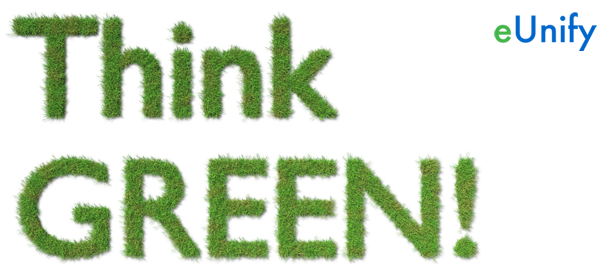 Let’s look at some ideas for going green in your HOA.
Let’s look at some ideas for going green in your HOA.
Reduce Paper:
Meetings: Depending on the size of the community, you could end up printing out an entire ream of paper for the collection of reports and documents needed to conduct a board. The truth is, most of these pages will end up getting thrown out very soon after the meeting. Consider distributing these packets in PDF or other file formats electronically. eUnify provides options for automated report subscriptions, an online Board Portal, and an interactive meeting agenda and reporting tool we call, “Client Activity Report” that can fully replace the need for hard copies of these meeting documents.
Letters: Some communications must be sent in hard copy to meet statutory requirements, but there could be room to make a shift to electronic copies for statements, courtesy letters, and architectural acknowledgement letters. eUnify allows you to make available all final copies of letters to homeowner accounts in the CommunityLink portal. These can also be set up to send automatically as emails to homeowners.
The world will never be paper-free, but we can probably cut paper use by a large margin with email and online strategies.
Vet Green-minded Vendors:
Make ecological considerations part of your criteria when vetting vendors. For example, there are many pest control services available now that use more natural pesticides that pose lower risk to pets and people, as well as insects that are beneficial. Such vendors might also employ a catch and release (in the wild) policy for certain critters native to the area burrowing or slithering through your landscape. Talk to painters about low VOC paint for common areas and buildings, or to landscapers about reducing chemical fertilizer and water use.
Update Landscaping:
Reduce water use by adopting a landscape design that makes use of plants native to your area. These plants have evolved to thrive in the natural conditions of your environment, so should require the least amount of water, chemical fertilizers, and care. Check for incentive programs with your local municipality. Many cities offer grants toward landscaping that reduces water use while helping to beautify the city.
Replace Lighting:
LEDs use far less energy than their incandescent counterparts and have a few key advantages over fluorescent lighting, including more color temperature options for warmer, more natural light, longer lifetimes, the absence of harmful mercury or other toxins, and more durable shatterproof materials. Blue light is known to be harmful to not only nature and the wildlife in it, but also to humans. While LEDs are great energy efficient lights, they tend to contain larger amounts of blue light. Therefore, lights should have a color temperature of no more than 3000 Kelvins. Look for “warm” lighting, or bulbs with an amber color, that’s lower in color temperature like low-spectrum LEDs. Some LED applications draw so little power, you might consider solar panel options for pathway and landscaping lights.
You might also consider using lighting fixtures that are “Dark Sky Compliant”. Generally, these are fixtures designed to minimize light pollution, glare, and light trespass from one property to another. These fixtures help reduce energy usage because they are designed to focus light where needed, rather than broadcast it generally into the night sky. Light pollution has been shown to alter migration patterns and otherwise impact wildlife, not to mention reducing our view of the awesome night sky to a few twinkling dots.
Going green really is a no-brainer because it simply means reducing resources used, which ultimately means saving money…go green and save some green!

